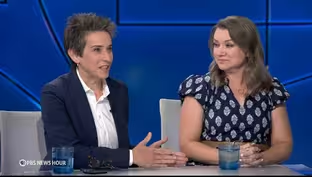
How partisan redistricting fights could decide next Congress
Clip: 8/18/2025 | 5m 58sVideo has Closed Captions
How partisan redistricting battles could decide the next Congress
Texas lawmakers are back in session after Democrats returned to the state after leaving to block partisan redistricting. Democrats came back because California is planning its own partisan map to counteract GOP gains in Texas. To discuss how the map battle could decide the next Congress, Lisa Desjardins spoke with Dr. Sam Wang of the Electoral Innovation Lab.
Problems playing video? | Closed Captioning Feedback
Problems playing video? | Closed Captioning Feedback
Major corporate funding for the PBS News Hour is provided by BDO, BNSF, Consumer Cellular, American Cruise Lines, and Raymond James. Funding for the PBS NewsHour Weekend is provided by...

How partisan redistricting fights could decide next Congress
Clip: 8/18/2025 | 5m 58sVideo has Closed Captions
Texas lawmakers are back in session after Democrats returned to the state after leaving to block partisan redistricting. Democrats came back because California is planning its own partisan map to counteract GOP gains in Texas. To discuss how the map battle could decide the next Congress, Lisa Desjardins spoke with Dr. Sam Wang of the Electoral Innovation Lab.
Problems playing video? | Closed Captioning Feedback
How to Watch PBS News Hour
PBS News Hour is available to stream on pbs.org and the free PBS App, available on iPhone, Apple TV, Android TV, Android smartphones, Amazon Fire TV, Amazon Fire Tablet, Roku, Samsung Smart TV, and Vizio.
Providing Support for PBS.org
Learn Moreabout PBS online sponsorshipGEOFF BENNETT: State lawmakers are back in session today in Texas, and that includes Democrats, who've now returned after leaving to block partisan redistricting.
The House speaker gaveled the chamber in for business for the first time in two weeks.
STATE.
REP. DUSTIN BURROWS (R-TX): We are done waiting.
We have a quorum.
Now is the time for action.
We will move quickly and the schedule will be demanding until our work is complete.
GEOFF BENNETT: Texas Democrats returned because California Democrats are planning their own partisan map to counteract any GOP gains.
STATE REP. MARC BERMAN (R-CA): I'm not happy to be here.
We didn't choose this fight.
We don't want this fight.
But with our democracy on the line, we cannot run away from this fight.
GEOFF BENNETT: Congressional correspondent Lisa Desjardins has more.
LISA DESJARDINS: Geoff, this battle of the maps could decide the next battle for Congress.
To dig into what's happening, we're joined by Dr. Sam Wang, director of the Electoral Innovation Lab, who has pioneered ways to analyze gerrymandering.
Sam, let's start with California.
If you look at the maps, the one on the left is the current congressional map.
And then on the right, you see what Democrats are now proposing.
Help us understand what Democrats are doing in California?
And how many seats do you think they could gain?
SAM WANG, Director, Electoral Innovation Lab: Well, Democrats are working with a map that is drawn by an independent commission and that commission went to efforts to represent different parts of the state.
So as a result, there are Republican-leaning parts of the state that are represented, Democratic-leaning parts of the state also represented.
Democrats have now sketched out a draft map that will pick them up around five or six seats.
And the way they have done it is by arranging parts of the state to be more favorable to them.
And so the independent commission tried to respect communities.
And now what the Democrats are trying to do is draw a map for the next few elections, a temporary map that will basically take Republicans and pack them into a smaller number of districts or split them and, through this artful arrangement, gain an advantage of a five-seat gain compared with the neutral map that's in place now.
LISA DESJARDINS: Texas Republicans are hoping to also gain at least five seats there.
But do you think they can?
Your estimate is a little different.
SAM WANG: It's going to be a little bit tough.
So the current Texas map is already gerrymandered to favor Republicans.
What they're trying to do is eliminate districts in the Dallas area, the Houston area, I believe San Antonio, and then along the southern border.
Some of that is going to involve drawing districts that violate the Voting Rights Act.
And so they're hoping to get the Supreme Court to go along with that and basically change the state of play for Hispanic voters in parts of the state.
The hard thing for them is that they have assumed that they're going to get performance like what Trump got against Harris in 2024.
But that could backfire, because, of course, voters can swing back and forth, and especially Hispanic communities because that's a constituency that's been moving fast in the last few years, could move back again because of actions by ICE and so on.
It's hard to predict how they're going to react to what's been happening over the last year.
And that's a gamble that Texas Republicans are taking.
LISA DESJARDINS: And we know the pattern with midterm elections anyways with an incoming president.
Usually, it goes the other way.
But, to your point, Texas Democrats are using strong language.
They are saying these maps are racist.
Republicans say that's offensive.
They say that's not true.
But in your analysis, what do you know about the shifts affecting different races and their power, their ability to be represented in Texas from the proposed map?
SAM WANG: Well, the state of the law right now, Lisa, is that districting has to follow a bunch of federal rules, including compliance with federal law on the Voting Rights Act.
And so there are districts in Texas now that respect that give Hispanic communities power.
And so redrawing districts to take away that is a natural consequence of drawing a partisan gerrymander because party and race are so often correlated.
Hispanic voters tend to vote Democratic in the urban areas of Texas.
And so doing away with those districts would naturally affect racial representation.
And so it's hard to change one without changing the other.
LISA DESJARDINS: How convoluted are these maps?
Are there any examples that stand out to you?
SAM WANG: Oh, there are some good ones.
Let's see.
So one that sticks out to me is the Texas, I believe the 32nd District, which is a district in the new draft that kind of starts in East Dallas and then goes out like a kind of like a tadpole shape.
And it goes out towards Arkansas and it gets most of the way to the Arkansas border.
And if you know Texas at all, from Dallas to the Arkansas border is a good long drive.
And so that's a shape that is basically a thing that gerrymandering can do for either Democrats or Republicans, make a kind of a pie slice.
That starts in a city and then goes out to rural areas.
LISA DESJARDINS: Overall, where do you think this now we see kind of fervent effort to look at redistricting puts Republicans and Democrats?
Who benefits here or what does it tell you about the parties?
SAM WANG: Partisan redistricting peaked 10 years ago in 2012, and until today, until this month, gerrymandering actually is somewhat lower than 10 years ago.
So now, with just a few seats in Congress needing to flip in order to give Democrats control, there's a certain whiff of desperation to try to find seats anywhere to flip control.
Now, in a median year, it only takes 13 seats.
A typical change in the midterm year is 13 seats.
And so Democrats and Republicans are trying to tilt that a little bit.
The major places where they're trying to do it are Texas, Ohio, and Florida on the Republican side, California on the Democratic side.
The net, if it all came to pass, would be in my estimation, in our estimation at the Electoral Innovation Lab, maybe five or six seats, so not quite as much as what typically happens when people change their minds in an election, but in a really tight race could make the difference.
LISA DESJARDINS: Sam Wang, thank you so much for talking with us.
SAM WANG: Thank you, Lisa.
How D.C. residents feel about crime and the federal takeover
Video has Closed Captions
Clip: 8/18/2025 | 7m 10s | How D.C. residents feel about crime and the federal takeover of their city (7m 10s)
New album reveals intimate reflections by Woody Guthrie
Video has Closed Captions
Clip: 8/18/2025 | 8m 26s | Newly released tapes reveal intimate reflections by Woody Guthrie (8m 26s)
News Wrap: Hurricane Erin roaring past Bahamas
Video has Closed Captions
Clip: 8/18/2025 | 4m 57s | News Wrap: Hurricane Erin roaring past Bahamas (4m 57s)
Tamara Keith and Amy Walter on the politics of redistricting
Video has Closed Captions
Clip: 8/18/2025 | 7m 48s | Tamara Keith and Amy Walter on whether Democrats can overcome GOP redistricting advantages (7m 48s)
Would ceding land bring peace to Ukraine? Experts weigh in
Video has Closed Captions
Clip: 8/18/2025 | 10m | Would ceding territory to Russia actually bring lasting peace to Ukraine? Experts weigh in (10m)
Zelenskyy gets promises of U.S. support in Trump talks
Video has Closed Captions
Clip: 8/18/2025 | 8m 5s | Zelenskyy gets promises of long-term U.S. support in White House talks with Trump (8m 5s)
Providing Support for PBS.org
Learn Moreabout PBS online sponsorshipSupport for PBS provided by:
Major corporate funding for the PBS News Hour is provided by BDO, BNSF, Consumer Cellular, American Cruise Lines, and Raymond James. Funding for the PBS NewsHour Weekend is provided by...
















